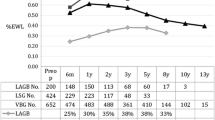Background: Predicting successful outcomes after bariatric surgical procedures has been difficult, and the establishment of specific selection criteria has been a subject of ongoing research. In an effort to choose the most appropriate surgical procedure for each patient, we have established a specific set of selection criteria for each procedure based on degree of obesity, preoperative dietary habits, eating behavior, and various metabolic features. Methods: From June 1994 to December 1998, 90 bariatric surgical procedures were performed at the authors' institution by a single surgeon (F.K.) based on specific selection criteria. Vertical banded gastroplasty (VBG) was performed in 35 patients, standard Roux-en-Y gastric bypass (RYGB) in 38 patients, and distal RYGB in 17 patients. All patients were monitored postoperatively 1, 3, 6, and 12 months and once per year thereafter, with an additional visit at 18 months in distal RYGB patients. Results: Early postoperative morbidity (<30 days) did not differ significantly between the three groups and averaged 9% of total patients. Long-term postoperative morbidity (>30 days) included 9 incisional hernias (2 in the VBG group, 5 after RYGB, and 2 in the distal RYGB group). There were 6 cases of staple-line disruption, 4 after VBG and 2 after standard RYGB, 1 of which resulted in stomal ulcer. Early postoperative mortality was 0%, and long-term mortality was 1.1%, which was due to pulmonary embolism in 1 standard RYGB patient on the 65th postoperative day. Average percentage of excess weight loss (%EWL) was 62% the first year, 61% the second year, and 50% the third year in VBG patients, and 63.6%, 65%, and 63.3%, respectively, in standard RYGB patients. In distal RYGB patients, where the patient number was significantly smaller, the %EWL at 1 and 2 years, respectively, was 51% and 53%. The most significant metabolic/nutritional complication was the appearance of hypoproteinemia (hypoalbuminemia) in 1 distal RYGB patient 20 months after surgery, which was corrected by total parenteral nutrition and subsequent increase in dietary protein intake. Significant improvement or resolution of pre-existing comorbid conditions was observed in all patient groups. The postoperative quality of eating, as evaluated by variety of food intake and frequency of vomiting, was significantly better in RYGB patients. Conclusions: These results show that selection of the bariatric surgical procedure to be performed in each patient based on specific criteria leads to acceptable weight loss, improvement in preexisting comorbid conditions, and a high degree of patient satisfaction in most patients. On the basis of our own observations as well as those of others, our selection criteria have become more strict over time and our selection of VBG as the operation of choice increasingly infrequent.
Similar content being viewed by others
Author information
Authors and Affiliations
Rights and permissions
About this article
Cite this article
Kalfarentzos, F., Dimakopoulos, A., Kehagias, I. et al. Vertical Banded Gastroplasty Versus Standard or Distal Roux-en-Y Gastric Bypass Based on Specific Selection Criteria in the Morbidly Obese: Preliminary Results. OBES SURG 9, 433–442 (1999). https://doi.org/10.1381/096089299765552701
Published:
Issue Date:
DOI: https://doi.org/10.1381/096089299765552701



